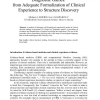127
click to vote
ISCI
2011
14 years 7 months ago
2011
We present a general rule induction algorithm based on sequential covering, suitable for variable consistency rough set approaches. This algorithm, called VC-DomLEM, can be used f...
101
Voted
CORR
2011
Springer
14 years 7 months ago
2011
Springer
— We consider the decentralized binary hypothesis testing problem on trees of bounded degree and increasing depth. For a regular tree of depth t and branching factor k ≥ 2, we ...
103
Voted
JUCS
2010
14 years 10 months ago
2010
: For the processing of decision making with uncertainty information, this paper establishes a decision model based on lattice-valued logic and researches the algorithm for extract...
101
Voted
ISCI
2006
15 years 10 days ago
2006
In this paper we have introduced a class of decision rules related to simple majority, by considering individual intensities of preference. These intensities will be shown by mean...
90
Voted
ATAL
2010
Springer
15 years 1 months ago
2010
Springer
We explore settings where a principal must make a decision about which action to take to achieve a desired outcome. The principal elicits the probability of achieving the outcome ...
IJCAI
2003
15 years 1 months ago
2003
Many different rules for decision making have been introduced in the literature. We show that a notion of generalized expected utility proposed in [Chu and Halpern 2003] is a uni...
MIE
2008
15 years 1 months ago
2008
A method of obtaining well-founded and reproducible results in clinical decision making is presented. It is based on "diagnostic games", a procedure of elicitation and fo...
RSCTC
2000
Springer
15 years 3 months ago
2000
Springer
Induction of decision rules within the dominance-based rough set approach to the multiple-criteria sorting decision problem is discussed in this paper. We introduce an algorithm ca...
87
Voted
KDD
1994
ACM
15 years 4 months ago
1994
ACM
Oneof the central goals of knowledgediscovery in databases is to produceknowledgeuseful for decision making. However,the form in which knowledgecan be easily discovered is often d...
116
Voted
PKDD
1999
Springer
15 years 4 months ago
1999
Springer
Abstract. We describe EDRL-MD, an evolutionary algorithm-based system, for learning decision rules from databases. The main novelty of our approach lies in dealing with continuous ...

